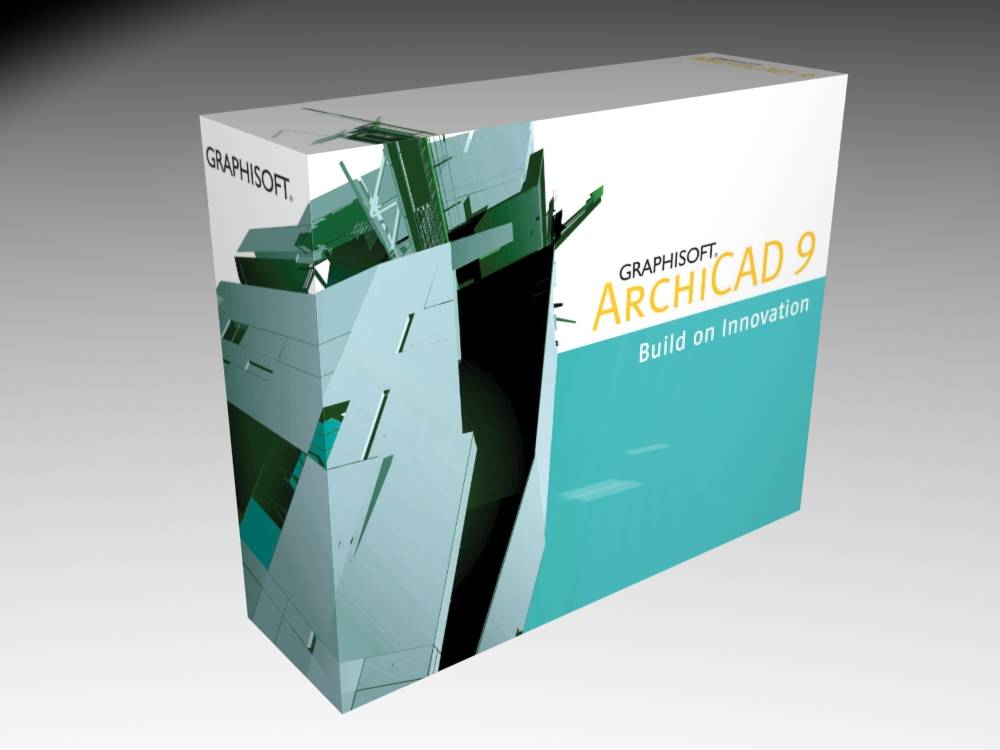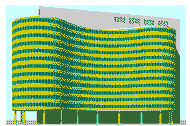|
|
 |
ARTICLES
|
 |
|
| The
Objects Amoung Us |
| They may
seem like visions of the future, but these architects - and thousands
more across the globe - use ArchiCAD's intelligent building objects
every day in these and other ways. |
| With a few
clicks of a mouse button, an employee at Champion Products can
change a store's Spring collection to Summer. He can also visualize
the new store interior, count inventory and track style numbers.
The ArchiCAD-based virtual merchandising system, developed by
Logikos in New York City, not only aids in controlling brand image,
but can greatly accelerate store planning and visual merchandising
work in an industry where time equals money. |
| Toronto
architect Willem Langelaan was able to clad a continuously curved
wall by setting MasterLibrary's spandrel curtain wall element
to one module wide by 12 stories tall and using ArchiCAD's "Multiply..."
command just once for each of the 3 curved wall sections. The
window elements adapted themselves automatically to the curvature
of the walls, resulting in a crisp and accurate representation
in both floor plan and perspective. |
| Thanks to
identical object libraries used in their respective offices, Architechnology
in Cincinnati, Ohio, and Design Integrations in Atlanta, GA.,
were able to exchange elaborate house models by email as they
fought a deadline to produce a collection of 12 custom homes for
Stephen Fuller/Design Traditions. |
| n Phoenix,
Ariz., the Orcutt/Winslow Partnership used original drawings of
Fountain Hills High School to create a 3D library of original
details and reassemble them quickly to generate a successful design
for an addition that maintained both a technical and aesthetic
continuity with the old school. |
| They may
seem like visions of the future, but these architects - and thousands
more across the globe - use ArchiCAD's intelligent building objects
every day in these and other ways. |
| ArchiCAD
has offered architects a building-object oriented working environment
since its first release in 1985. ArchiCAD's external libraries
of building parts are unique because they simultaneously manage
and store the three essential types of information needed to design
and document buildings: |
- 3D
geometry and finishes for producing renderings and calculating
surfaces and volumes,
- multiple
2D CAD symbols to repre- sent the object at different scales
and conditions such as the DIN vs ANSI drafting standards
or product variations within a product line, and;
- text
information for specifications, quantity take-offs, calculations
such as heat loss/gain, cost estimating, and inventory tracking.
|
| ArchiCAD's
object technology extends beyond libraries of building products
and underpins all of the architectural elements of a building.
For example, walls in ArchiCAD are not just parallel lines in
plan; they can contain valuable information about their composition,
materials, finish, height, price and connection to other walls,
columns, floors and ceilings. All of this data is viewable in
the form of perspectives, elevations and the bill of materials
which are generated automatically from the floor plan. |
| Equally
important is ArchiCAD's ability to alter an object's appearance
and behavior according to rules which can be embedded within objects.
For example, a staircase, when enlarged graphically in plan, can
"know" that new treads should be added according to a given rise-to-run
ratio rather than simply making the treads appear wider; a door
can "know" that, when it is displayed at large scale in plan or
section, additional detail should appear; a window can "know"
that it is an Andersen brand casement and that only certain trim
and hardware are available for it; a wall can "know" how to wrap
its sheathing around a column; a steel beam can "know" that its
length can be changed but never its cross section. |
 |
| Curvilinear
building by Willem Langelaan using a curved glazing system. ArchiCAD
delivers this intelligence to architects around the world by using
the "Geometric Description Language," or GDL. Developed by Graphisoft
in 1982 and continuously improved ever since, GDL is the foundation
technology of ArchiCAD and the common format for the tens of thousands
of building parts in existence today. |
| Similar
to common printer languages such as Adobe's Postscript and Hewlett-Packard's
Printer Communication Language, GDL describes geometry in a language
(i.e. text) form. Unlike these languages, however, GDL describes
objects in three-dimensions as well as two-dimensional drafting
symbols and lists of properties. GDL contains "geometric primitives"
which describe shapes such as BRICK, CYLIND(er), and MESH; "transformation
statements" which define scale, orientation and location using
x, y and z coordinates and statements such as MOV(e), ROT(ate),
MULT(iply); and "directives" which describe the object's appearance
using material names such as PINE. When ArchiCAD is used, these
GDL statements are "executed" which make the objects described
by GDL behave and appear as either rendered views, CAD symbols
or a list of properties and values. |
 |
| Logikos'
virtual merchandising system helps retailers layout space & track
inventory. In addition to its rich description language, GDL features
a scripting interface resembling the BASIC programming language.
Architects can simply write "scripts" of how objects should appear
and act under certain circumstances or "parameters." Users can
enter variables such as unit cost, heat loss, or pieces/area in
the script or through graphic dialogs. These variables can then
be used in formula to dynamically track project cost, energy use,
materials used or almost anything which can be derived from the
building's surface or volume. |
| A GDL object
can also reference another GDL object, data from other software,
or external information from ArchiCAD such as drawing scale, view
point, and local origin. External databases can be accessed by
GDL's open-architecture so that values from a database can directly
impact CAD drawings and, conversely, changes made in the drawings
can directly impact values and specifications in a separate project
database. GDL can also store parameters to be used by external
applications, such as StairMaker and ArchiSITE, which are written
especially to work inside of ArchiCAD. |
| GDL was
the first intelligent building object technology for architects
using desktop computers, and Graphisoft will continue to enhance
GDL and expand its reach and availability. If standards are set
by common use and accessibility, then the GDL format employed
by ArchiCAD is truly a standard today. If standards are a reflection
of superior and ever-improving technology, then GDL will be a
standard for tomorrow as well. |
|
|
|